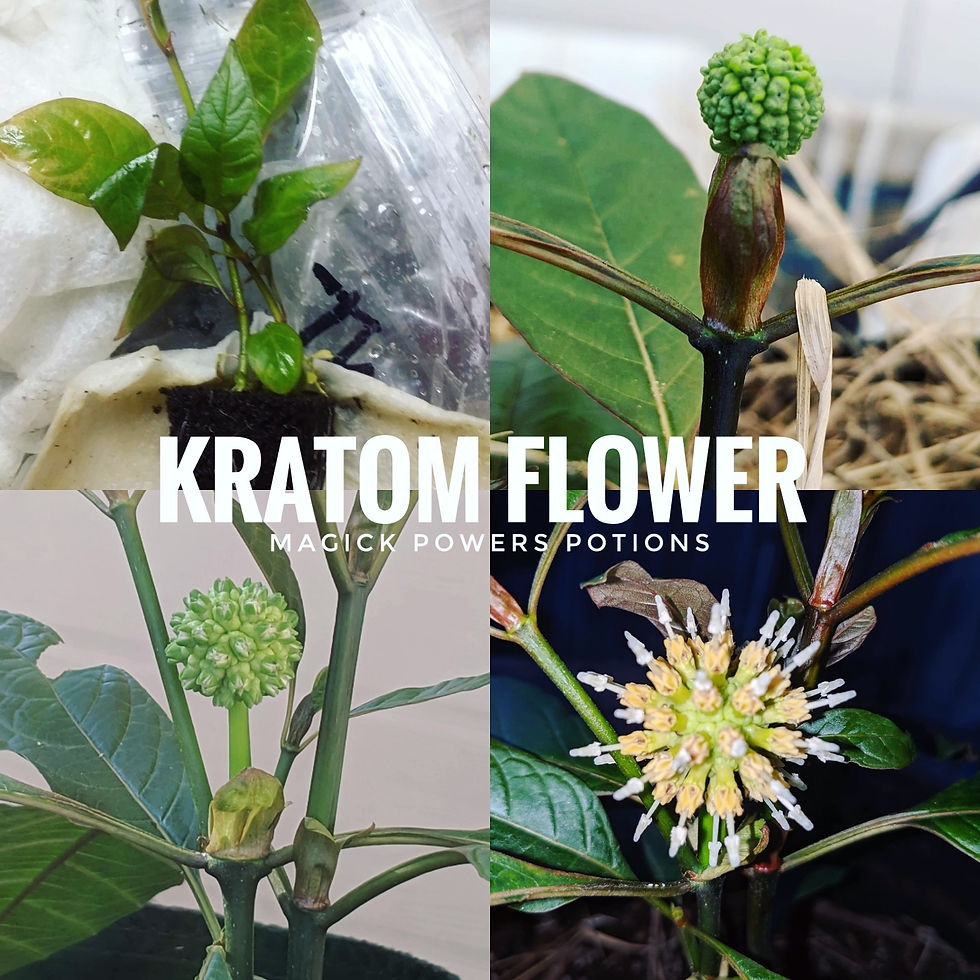Early Flower Development
- Magick Powers

- Jun 19, 2019
- 4 min read
Updated: Aug 2, 2019
These unique kratom plants were sown from seeds containing the genetic instructions for early sexual development (13 photos plus video)

As we endeavor to cultivate and study a broad spectrum of diverse kratom genetics, we chanced upon seeds containing the genetic instructions for early sexual development. Only a few months after being sown, the tiny seedlings produced by these seeds began developing sexual organs. This phenomenon was exclusive to one particular batch of pods, expressing itself multiple times within the specimens germinated from the genetic material.
The characteristics of early sexual development were expressed across multiple batch experiments, sown at different times and under different environmental conditions. The seeds were the common factor, suggesting the phenomena is genetically linked.

After a decade growing and breeding in the medical cannabis industry, resident hedgewitch Cornelia Llama is excited to focus her plant magick on another species. "Mitragyna speciosa is an untapped goldmine of potential genetic variation," says Llama. "Although kratom doesn't yet seem to have genetically reproducible phenotypes, or strains, like cannabis does, there is unlimited potential to selectively breed for traits thanks to the simple power of genetic diversity."
According to Llama, an intentional cross-breeding of the small early-flowering specimens and larger specimens that exhibit rapid growth but slow sexual maturity may yield big trees with early sexual function.
"In a country where this species is primarily represented by a few old clone lines, and everyone has little pieces of the same trees, this kind of thing is immensely exciting," says an enthusiastic Llama, who is an outspoken advocate of biodiversity.

Seed selection has previously been limited to southeast Asian farmers grabbing a low-hanging pod easily within reach, but recent interest in the agriculture of kratom has spread to others now, who are seeking seeds from trees with desired traits.
"In the future, we hope to selectively breed not only for beauty, size and sexual function, but insect resistance, low-humidity resistance, frost resistance, and of course alkaloid profiles," Llama says.

Llama and her colleagues are busy sourcing genetics from a variety of origins, and tagging the developing plants for traits. Because the species is bisexual, copies of desirable plants can be cultivated organically from the production of seeds in self-fertilized specimens, and cross-breeding can yield a litany of potential variations.
Of course, this is completely dependent on the production of sexual organs.

Research suggests that among American growers, flowering kratom is not commonly observed. Although it certainly exists, if you're looking at overall numbers, it's a very small percentage that gets to flower ---- in spite of the fact that many kratom tree owners are growing rooted cuttings of the same genetic line, and essentially own little pieces of the same sexually mature tree.
"Age wise, every clone from one of these old lines should flower immediately or at least within a year. It's a branch from a sexually mature tree," says Llama's colleague David Winkler. "But that's not what's happening."
Instead, some cuttings take ten years to flower, and many never do ---- even though they are genetically identical to the mother tree from which they were cloned. Llama and Winkler suspect this may be due in part to genetic characteristics of the common clone lines, and enough experimentation with fresh genetics will yield more and earlier sexual productivity.

"The perfect American kratom trees would, first of all, be genetically diverse," says Llama, "but they would also be beautiful, hardy, fast growing, sexually productive and alkaloid rich. We don't have to accept the old clone lines as the be-all-end-all of American kratom. We have the power to steer this ship. It comes down to selectively breeding for traits. This has been going on for hundreds of years with dog breeding. Then marijuana breeding. So why not kratom?"
Both Llama and Winkler believe seed-sown genetic diversity holds the key to developing trees perfectly suited to the American landscape, where kratom has gained widespread popularity over the last two decades.

"It's a numbers game," says Winkler. "Grow enough trees from seed, and you're eventually going to hit the jackpot."
"DNA is massively intelligent," says Llama. "In its infinite permutations, you'll start finding things you haven't seen before, and the will of nature to survive, thrive, adapt and evolve cannot be underestimated."
The early flowering genetics Llama sourced for Magick Powers Potions should be enough to drive that point home.

"It takes a lot of seeds, a lot of time, a lot of room and a lot of observation," says Llama. "And a little luck too."
And maybe little bit of craziness, because really, who is nuts enough to do this all day? And then spend their free time writing about it in the third person?

"I sent out quite a bit of this genetic material to various individuals and organizations," says Llama. "Not just here in the US, but to various places in the world. Who knows, we might have kratom flowering all over the place soon."
If you are looking to grow your own kratom, visit Magick Powers Potions for genetically diverse live specimens.
Note to potential collaborators: we are constantly on the lookout for fresh genetic material to study. If you would like to contribute genetic material or participate in our genetic studies, please contact Magick Powers Potions at magickpowerspotions.com or via the official facebook page.






Comments